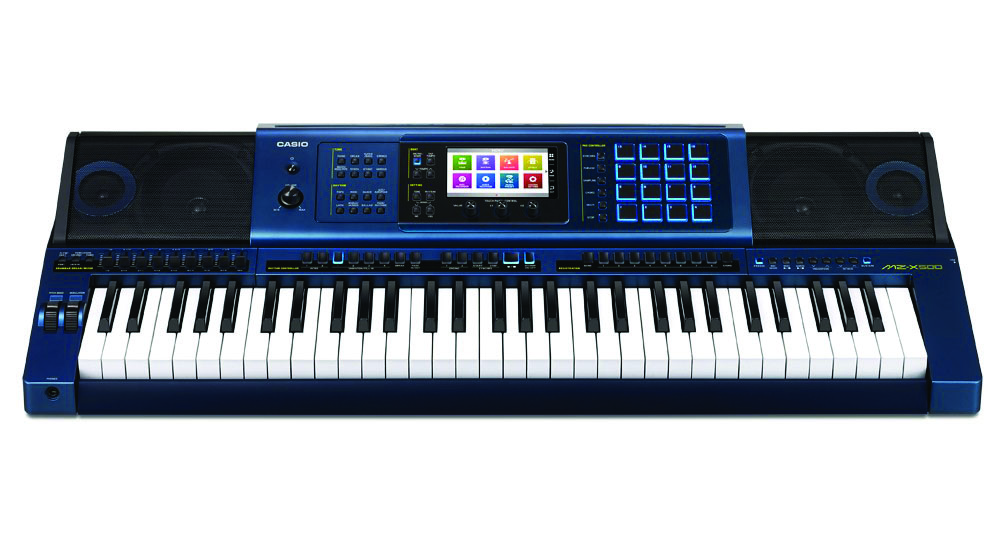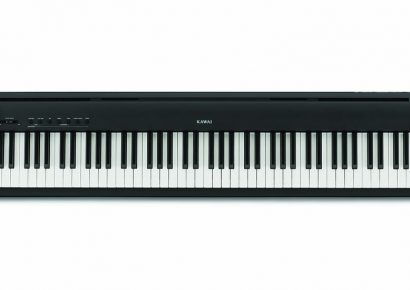The keyboards are so jam-packed full of sounds and features they’re probably more suited to the ‘workstation’ name with sound editing and interface features that out-do many competitors at this price point, so let’s take a closer look.
FIRST IMPRESSIONS
Upon turning on either unit, you’re greeted with one excellent sounding grand piano emulation, with a smidge of reverb. The keys aren’t fully weighted, but have a great feel and resistance with minimal wiggle. The two instruments are identical in size and shape, the only difference being that the MZ-X500 have16 pads, as opposed to the MZ-X300’s four. The bodies themselves are plastic but feel very sturdy and well made. I’m ordinarily fairly sceptical of built in speakers, but cranking up the volume on these machines proved they’re certainly up to the task of filling a reasonably large room. The touch screen is bright and easy to navigate for anyone that has used a smart phone before, with all features of both machines easily accessible via their own menus.
SOUNDS
The bank of buttons labelled ‘Registration’ are sets of preset group sounds, rhythms and effects. Tapping on the ‘Tone’ reveals the four sounds programmed onto your current registration, easily enabling you to turn any of the four tones on/off with a simple tap of the screen. Playing through the registration presets, it’s clear that the sounds are of an excellent and realistic quality. They are multi-layer and velocity switched with high-fidelity samples. Once you dig into the actual Tone menu you will see tones divided into eight categories: piano, organ, guitar/bass, strings, brass/reed/pipe, synth, ‘ethnic’ and General MIDI.
Piano covers a huge range of sounds from Mellotron and Rhodes sounds, through to your 80s FM pianos and modern acoustic pianos. Organ covers just about every sound you could want, from overdriven rock to pipe to drawbar organs, the later using the physical sliders, with a range of period correct effects like phasers and rotary speakers. The guitar sounds are complete with string and fret noise, covering nylon and steel acoustic, right up to proggy flanged sounds and slap bass.
Strings covers various degrees of orchestral realism with the additions of choir and synth strings options. Brass/Reed/Pipe covers all the usual suspects complete with noisy breath sounds – tubas, saxophones, trumpets, pan pipes, oboes, bassoons and synth brass. The Ethnic section is separated into Latin, Indonesian, Chinese and ‘Others’ – a lot of the featured instruments won’t be familiar to your average Australian user, but they’re a lot of fun and sound fantastic.
General MIDI is full of your standard General MIDI sounds formed over the last few decades, not to say they aren’t without their uses. The Synth section features a vast range of modern and classic synth sounds and is one of the areas that the MZ-X500 differs from the MZ-X300, with an additional two categories on top of the X300’s lead and pad; bass synth and hex layers.
Hex layers feature six sound modules layered onto one tone, and considering that you can have four separate tones playing at once, that’s a large amount of horsepower under the hood. A neat trick with the hex layers is to set sounds to only be triggered at a certain velocity, so you can get a roaring full orchestra if you hit the keys hard, or just some strings if you play soft. Each layer can also be controlled via the drawbar sliders.
EDITING SOUNDS
Once you’ve decided on a tone you can actually get very deep into sculpting that tone even further by tapping edit. All of the usual suspects on your standard synths are here; envelopes, filters, velocity sensitive etc, as well as the ability to edit the effects. The organ editing options are extensive, with options going as far as running noise and drawbar leakage. It’s a bit of menu diving, but it’s all very painless and fast with the big touch screen. Available effects include a range of reverbs and delays, chorus, flanger and phasers and plenty more too numerous to list. There is a touch screen X/Y pad to help you find the perfect setting for each effect, or you can just adjust in real time. Reverb, chorus and delay can work as sends, which is a great feature to ensure that you don’t lose all the detail in your sound. Once you’re happy with your creation, you can save it as a preset in one of the user tone slots.
THE PADS
The four pads on the MZ-X300 can play samples or phrases. The phrases will also automatically transpose to be in key with your auto-accompaniment’s chords if you choose, and can sync with the chosen tempo. The MZ-X500 has 16 velocity sensitive back-lit pads, which expand the functionality significantly with an added chord function and a ‘multi’ function that splits the 16 pads into functions of your choosing. For example, drum sample on one pad, chords on another, including MIDI generated musical inflections to what you’re playing on the keys. All of the options are accessible from the pads menu on the touch screen and both the MZ-X300 and MZ-X500 can also record custom samples to be played on the pads.
RECORDING
Being an arranger keyboard series, of course you can arrange a complete song using the inbuilt MIDI recorder. There are 16 tracks, plus the master track available for recording and arranging with a substantial 50,000 note sequencer capicity. The usual editing tools are there – cut, copy, paste and quantise. To bounce the audio out, you just to plug in a USB memory stick and you’re good to go. Records everything played in real-time on the keyboard (including accompaniment Styles, MIDI tracks), plus everything plugged into the numerous audio inputs (which can use the powerful on-board DSP EFX unit) as a .WAV file, as a “one-shot” recorder.
FIRMWARE UPDATE
Casio is committed to adding new features and sounds to the MZ-X300 and MZ-X500. The latest update is v1.4, which adds 40 new accompaniment rhythms (Australia’s Casio team are the leaders when it comes to the development of these new rhythms) and styles, significantly improving the already well featured library. Feature-wise it adds a playback function to the MIDI events editor, a custom file management system and an MP3 playback function. Updates are available as they are released via casio.com or soundtechnology.com.au.
All in all, you get a lot of bang for your buck here. I was incredibly impressed with the depth of sound editing and the range of included sounds. The hex layers function on the MZ-X500 truly pushes the envelope as to what’s possible with the humble keyboard. Deciding between the two comes down to deciding what functionality you need and whether you’ll take advantage of the extra pad functionality and powerful sound sculpting of the MZ-X500.

